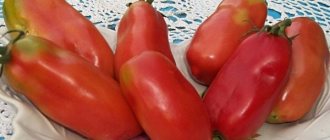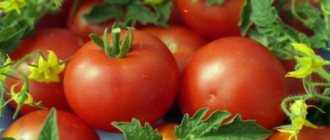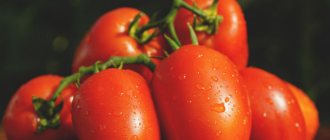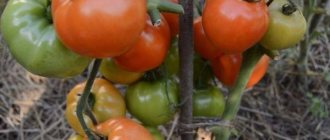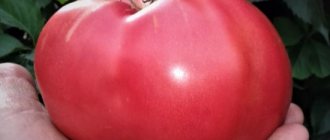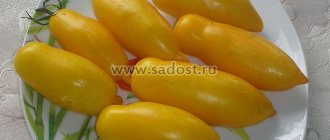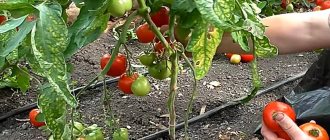Tomato Gilgal F1 has a special place in the tomato world. It is highly valued for its productivity, excellent taste, and the possibility of wide application.
| Height | Landing location | Ripening time | Fruit color | Fruit size | Origin | Fruit shape |
| Tall | Greenhouse, Open ground | Mid-early | Reds | Large | Hybrid | Flat-round |
General description of the variety
This tomato belongs to the group of first generation F1 hybrids. The advantage of such tomatoes, compared to natural varieties, is that they are more stable in terms of development under unfavorable conditions. At the same time, judging by the reviews of summer residents, Gilgal, among other things, is also devoid of the main drawback of many hybrids recently bred by breeders - the not very well expressed taste of the fruit. Tomatoes on such bushes grow fragrant, with tender and juicy sweet and sour pulp.
It is possible to grow the Gilgal F1 tomato variety in suburban areas both in open and closed ground. Since these tomatoes are indeterminate, they grow quite tall both in the beds and in the greenhouse. The manufacturer of this hybrid claims that the length of its stem over a season can reach 2 m. However, summer residents on specialized forums usually speak of Gilgal as a moderately tall tomato.
Tips for growing tomatoes in a greenhouse: video
Tomato Gilgal F1 has a special place in the tomato world. It is highly valued for its productivity, excellent taste, and the possibility of wide application.
| Height | Landing location | Ripening time | Fruit color | Fruit size | Origin | Fruit shape |
| Tall | Greenhouse, Open ground | Mid-early | Reds | Large | Hybrid | Flat-round |
Tomato Gilgal is an indeterminate tall hybrid. The height of the bushes can reach 1.8 m. 3-5 tomatoes are formed on the fruiting clusters; in total, no more than 7-8 clusters are left on the shoots.
The shape is round, slightly flattened. The ribbing is moderate in the area of the stalk. The color is bright red. The pulp is fleshy and juicy. The taste harmoniously combines sourness and sweetness.
Tomatoes are planted in greenhouses in cool summer conditions, in open beds in the south.
Sowing the seeds of this tomato for seedlings is carried out 60-65 days before the intended planting in the ground. Seedlings dive at the stage of two true leaves. When planting seedlings in the ground for 1 sq. up to 4 plants are placed per meter of plot.
Further care for tomatoes consists of timely watering, fertilizing with complex mineral fertilizer, pinching and preventive measures to protect against diseases and pests.
When growing tomatoes in a greenhouse, we recommend installing a drip irrigation system - this will save your time and effort, as well as increase plant productivity and reduce the risk of late blight.
If you grew Gilgal f1 tomatoes, please write whether you liked them or not. What was the yield and taste of the fruit under your conditions? Will you grow them again? If possible, attach a photo of your tomatoes to your comment. Thank you!
Your reviews of the Gilgal tomato and additions to the description will help many gardeners evaluate this hybrid more objectively and decide whether it is worth growing or not.
I chose the Gilgal variety for growing in a greenhouse. It has early ripening, is easy to care for and produces a good harvest of tasty tomatoes. Tomato ripening is consistent. In warm regions it can be grown in open ground. The crop has a round shape. Weight from 200 to 300 g. The skin is thin, so tomatoes are well suited for canning.
The tomatoes are all approximately the same size - 200-250 grams, all round and beautiful in appearance. The skin is not too thick and cannot be felt in the mouth. The seed chambers are deep, with a large number of seeds, filled with aromatic liquid. The taste is pleasant, not sour. Care is required from the moment of planting in open ground or a greenhouse - the bushes are tall, they need to be formed into 1-2 stems and constantly tied to trellises.
Excellent tomatoes, with a pronounced tomato taste. I like that they have a thin skin and a round shape. This makes them suitable for preparing salads and for canning. They are also unpretentious for transportation. So bringing them from the dacha is not a problem. At the same time, the tomatoes grow quite large, each of them weighs 200-300 grams.
Tomato Variety Gilgal f1 belongs to the family of good quality hybrid tomatoes. If we compare them with natural tall varieties, then f1 hybrids have higher and more stable development characteristics under unfavorable bush breeding conditions.
In addition, they will need less attention to themselves during the entire ripening period. They are not demanding and have excellent yields; they can produce tomatoes in climates with possible sudden changes in weather, temperature, and also in conditions of light deficiency.
The indeterminate tomato variety Gilgal is included in the State Register of Breeding Achievements. The hybrid can be grown under film cover, in a greenhouse and in open soil.
The mid-early Gilgal tomato belongs to the BIF group (that is, large-fruited varieties). It will begin to bear fruit after 110 days have passed after the sprouts appear. At the same time, it is advised to lead his bush into 2 shoots.
The recommended planting pattern is 70 x 40 cm.
During the growing season, tall bushes will need to be tied to the support and excess stems removed. In this case, the plant can reach 1.8 m in height. About 5 fruits can form on fruiting clusters, and in total about 8 clusters are left on the plant. The bush is powerful with short internodes.
The first inflorescence is formed above the 7th leaf. The tomato foliage is medium in size and colored in a rich green color. Unripe tomatoes have a light green color. And when ripe they turn red.
Ripe tomatoes have a round shape, a fairly dense structure, they are approximately the same in size, slightly ribbed, but their weight can reach about 300 grams with a pronounced taste. After full ripening they acquire a distinct tomato taste.
If the variety is grown in film tunnels, you can harvest more than 15 kg of tomatoes from one plant. The characteristics and description of the variety indicate the possibility of transportation over longer distances and excellent keeping quality.
READ MORE: Irbitan potato description and characteristics of the variety, yield with photos
Like any variety of tomatoes, it also has advantages and disadvantages. So here are the advantages:
- Good productivity;
- Excellent product characteristics;
- Transportability;
- Undemanding;
- Disease resistance.
But the only disadvantage of the variety is the need for gartering and shaping.
Productivity
When grown in open ground, it is possible from 1 sq.m. remove about 16 kg of fruit. But when grown in greenhouse conditions, about 40 kg of tomatoes are harvested per square meter.
Living in the southern regions, you can do without the use of greenhouses; in places further north, it is necessary to grow in a greenhouse.
If the region is even further north, then it is better not to grow this type of tomato, since the harvest will not be large enough and you will need to wait longer than others.
The bush can bear fruit for 6 months, and also only in spring-summer and autumn.
Other interesting tomato varieties:
- Tomato Dubrava
- Tomato Gina
- Tomato Marusya
- Tomato Pickling miracle
Seeds for seedlings should be planted approximately 65 days before the expected date of planting in the soil. Before this, the seeds should be treated in an aqueous solution of aloe juice and then sown in a container with soil mixture.
Before planting, the soil should be fertilized; grooves are made at intervals of 5 cm from each other, 1 cm deep. Seeds are also laid out at a distance of 1 cm.
In order for seedlings to emerge almost simultaneously, the seedlings should be irrigated with warm water, and the container is then covered with polyethylene to create a greenhouse effect.
During the formation of 2 real sheets, diving is performed in separate containers. Transplanted seedlings are irrigated with warm water and placed in a dark place for 2 days. After the formation of the first bunch with a peduncle, the temperature should be reduced to 20 degrees.
Seedlings can be grown without diving, sowing directly into peat pots with substrate. 10 days before planting in the soil, watering should be reduced and plants should be hardened off by lowering the temperature.
To plant tomatoes, the soil must be prepared in the fall. And you can improve the soil structure with the help of peat, straw and organic matter. The formed seedlings are transplanted into the soil after the end of the spring frost period.
Tall plants will require additional nutrition, so complex fertilizers containing potassium and phosphorus must be added to the soil.
During the growing season, special attention should be paid to hilling the bushes, and you also need to loosen the soil to stimulate the growth of plant roots.
I grow this variety for the whole family. Since there are many of us, we need a large harvest. To obtain it, I sow seeds for seedlings with my own hands and during their growth I carefully monitor irrigation, fertilizing and slaughtering. Then, when transferring seedlings into the soil, fertilizers are certainly required, and then tying up the stems.
I really like the Gilgal variety, as it always produces tomatoes in large quantities, and the fruits are very tasty and sweet. Tomatoes are suitable for both salads and canning.
The variety is undemanding in cultivation; it only requires watering and fertilizing. Also, from time to time you should remove excess shoots from the plant.
Of course it is a little different from other varieties. Its height reaches about 1.8 meters, and its shoots are more powerful. True, they grew in our middle row, and if the others got at least some moisture after the rain, then they didn’t. The tomatoes are slightly larger in size.
I planted the Gilgal variety. I chose it because of its large harvest and sweet taste. It does not need special care, it is only important to irrigate and fertilize the plants on time. The whole family eats canned tomatoes all winter.
Tomato Gilgal F1 is recommended for growing for sale. This is facilitated by high productivity, the ability to retain commercial properties for a long time, and endurance to adverse factors.
Productivity
The characteristics of the Gilgal tomato in terms of yield, as gardeners note, are very good. This variety is valued by gardeners primarily because it produces quite a lot of fruit. Many gardeners especially recommend Gilgal for large families. The yield of this hybrid in open ground can reach 16-20 kg/m2. When grown in a greenhouse from the same area, gardeners often harvest up to 36 kg of Gilgal tomatoes.
The fruits on the bushes of this variety ripen quite large. On average, their weight is 250-300 g. The first inflorescence of the hybrid is laid above the 5-7 leaf, the subsequent ones - after 2-3 leaves. Experienced gardeners recommend putting no more than 5-7 brushes on one such plant.
Gilgal fruits have a flat-round shape. In the area of the stalk, they have slight ribbing. The color of tomatoes of this variety is rich red. When cut, Gilgal tomatoes have a pink tint.
Why is a hybrid better?
Hybrid tomato provides the following advantages:
- High yield;
- Ripeness occurs earlier;
- The growth of the bush is the same for all stems;
- All fruits of the same flowering are approximately the same size;
- The color is uniform, without spots;
- The fruits have a high content of biologically valuable substances;
- High plant resistance to pests and diseases;
- Resistance to changes in environmental conditions;
In conclusion, it is worth saying that a greenhouse cannot provide a 100% guarantee of favorable conditions; even here nature can make its own adjustments. It is better to plant several varieties that have different properties and ripening times. It is recommended to combine ordinary tomatoes with hybrid ones, and also read the information about the description of the variety.
It is difficult to choose one of what is available on the market, since today there is a large selection of different varieties. In this case, you should rely on personal experience and experimentation with the use of new varieties, taking into account the opinion of experts, as well as reviews of the Gilgal f1 tomato.
Tomatoes can now be bought in any supermarket and at any time of the year. But it’s not at all clear what they are “stuffed with.” And growing your own harvest and making your family happy, knowing that there is nothing unnecessary or harmful in vegetables, is, of course, great.
But a person who wants to plant tomatoes in his greenhouse always faces a choice: which seeds to buy in order to get the desired quality and a good harvest. Many gardeners have long decided that it is better to sow tomato hybrids in greenhouses.
We will look at why this is so in this article.
A hybrid is obtained by crossing two varieties that have some desired qualities. For example, one variety is characterized by high yields, but cannot resist diseases. The other has immunity against diseases, but the number of tomatoes harvested per season is much less. The hybrid has a number of advantages:
- the seeds sprout together;
- less demanding on growing conditions;
- more resistant to diseases;
- has improved taste compared to pre-hybridization;
- The yield is much higher, the fruits are even.
The second generation hybrid will not give the same results as in the first year of cultivation. Therefore, seeds will have to be purchased every year.
Before choosing the desired variety of tomatoes, you need to know their main characteristics. And also remember that it is better to grow varieties and hybrids acclimatized in a given area. Therefore, plants created by Russian breeders are suitable.
It may not be strange, but the yield of tomatoes in a greenhouse depends on weather conditions. The more sunny days, the faster the fruits ripen. And also from good agricultural technology.
With the right approach and good weather conditions, you can collect up to 10 kg of fruit from one bush, and half as much in open ground. But each variety has its own yield. So the hybrid Sumochka is about 16 kg per square meter, and Evpatoriya is up to 40 kg.
Russian size – 10 kg. You can increase productivity in the following simple ways:
- From each cluster of determinate varieties you need to cut several green fruits. Then the remaining fruits will be larger;
- You can place buckets of manure around the perimeter of the greenhouse. The concentration of carbon dioxide increases, and tomatoes grow faster.
Productivity cannot be increased by uncontrolled application of mineral fertilizers.
Bush type
Determinant. Or limited in growth. The growth of the central stem ends with a flower cluster and the movement of the strongest lateral shoot begins. These are hybrids such as Volgograd, Cavalcade and others.
Indeterminate. Not limited in growth. That is, you will have to pinch the top of the bush at the desired height. Example: Krasnobay, Gilgal, Ural, Typhoon F1.
Depending on the power of the plant, it is formed from one to three stems.
Greenhouse tomatoes are divided into early, medium and late ripening. The days from planting seedlings to harvesting the first harvest are taken into account:
- early ripening (90 - 95 days). Cavalcade, Evpatorius, Agatha, Aphrodite;
- mid-season (100 – 110 days). Krasnobay, Sibiryak, Miracle of the Earth;
- late ripening (from 115 days). Ural, Volgograd, Russian size, Snowfall;
Volgogradsky is mid-season and bears fruit after 110 days
Hybrid plants resist diseases better than varietal tomatoes. Resistant to fusarium, cladosporiosis, tobacco mosaic.
Manifestation of cladosporiosis of leaves
You cannot rely on this feature of hybrid tomatoes. Disease prevention measures will protect against crop loss.
Late-ripening varieties are stored for a long time. Gardeners collect them at the stage of milk maturity.
The fruits lie for some time in a dark place and at room temperature (7-20 degrees), ripening to the desired condition. But these tomatoes have a peculiarity - they have rough skin and the taste is slightly lost.
Typically, the raceme varieties are stored better. Until the New Year, the fruits of the hybrids Long Keeper, Sochelnik, Zazimok, and Red Stone may lie.
Every vegetable grower knows that it is better to grow zoned varieties. Or hybrids that were bred by domestic breeders. Among them there are both tall and low-growing tomatoes. As well as hybrids of different ripening periods. And the weight of the fruits is also different, which allows them to be used for their intended purpose. Therefore, there is plenty to choose from to get the desired result.
Ural F1
Ural is one of the largest-fruited mid-season hybrids. The fruits can be harvested on the 115th day after the first shoots appear. The bush is indeterminate, so it can grow upward, while laying more clusters than any low-growing variety.
When the center conductor reaches the roof of the greenhouse, it is simply pinched. The brush is not branched and is firmly attached to the central trunk. During the fruiting period, up to 10 of them are planted. The largest tomatoes in the first clusters can weigh up to 400 grams, but on average 200 grams per bush. That is, five fruits – a kilogram. The yield of the Urals is up to 10 kg per square meter.
The fruits can be harvested on the 115th day after the first shoots appear. The shape is round, slightly flattened. The surface is smooth, but there may be slight ribbing in the upper part of the fruit.
Characteristic feature: there is no green spot in the place where the stalk grows. The fruits are dense. And this suggests that they are poorly susceptible to fungal diseases and have good transportability.
The cultivation technology is no different from other varieties.
True, there are features:
- mandatory stepsoning. Leave no more than two stems;
- pinching the top.
The hybrid is resistant to the fungal disease brown spot.
Krasnobay F1
Mid-early hybrid. It takes about 3 months before the first harvest after planting the seedlings. The plant reaches a height of one and a half meters.
Recommended for cultivation only in greenhouses, since it does not have time to ripen in temperate Russia. The fruits are large. They can often reach half a kilogram.
READ MORE: The best varieties of yellow and orange tomatoes with photos and descriptions
In the central regions of Russia, it is possible to obtain a harvest only in closed ground due to the late ripening period.
Handbag F1
A mid-season hybrid, tall, and therefore requires gartering on a trellis and pinching. When forming a bush, leave no more than two stems.
The fruits are red with a pink tint, slightly flattened on the sides. Meaty, dense. Weighing up to 250 grams. Lying, transportable. Almost no cracking. With the right agricultural technology, you can grow about 16 kg of tomatoes per square meter in a greenhouse.
Cavalcade F1
Determinate variety, early ripening (90-100 days). 4-6 fruits weighing up to 150 grams are tied on the brush. Tomatoes are round, but there are also slightly flattened ones at the top. They may also be slightly ribbed near the stalk. Resistant to brown spot, fusarium wilt, and nematodes.
The fruits are fast-growing and transportable. The marketable yield is about 15 kg per square meter. The tomatoes are delicious. Suitable for storing for the winter.
Read about how to store fresh cucumbers in the refrigerator here.
Gilgal F1
The plant is indeterminate, up to 180 cm high. Mid-season variety for growing indoors. Among the main agrotechnical measures are lifting onto a trellis, pinching the top, and pinching. The plant is formed into no more than two stems.
The fruits are round in shape, almost equal in size and reach up to 300 grams. The standard color is deep red. Good taste.
Fruiting occurs 110 days after germination. Productivity up to 40 kg per square meter if all agrotechnical requirements for growing this hybrid are met.
An early ripening variety with excellent taste. Tomatoes are suitable for both fresh consumption and canning. Three plants per square meter are planted in greenhouses in mid-May. After just 110 days you can harvest the first harvest. Fruit weight up to 150 grams. Productivity reaches up to 40 kg per square meter of area.
The variety is indeterminate, that is, tall. Caring for all greenhouse tomatoes: watering, fertilizing, pinching, loosening, tying to a trellis.
Read about how to grow onions in a greenhouse in winter here.
Evpatorium F1 is resistant to most tomato diseases.
The Volgograd variety has long been loved by vegetable growers. For unpretentiousness, good productivity. And the hybrid Volgogradsky 5 95 surpassed varietal vegetables in all respects. At low cost and with a minimum of effort, you can get a wonderful harvest of delicious fruits.
Mid-late tomato hybrid. About 120 days pass from planting seedlings to the first ripe tomatoes. The leaf blades are emerald green. The plant is determinate. The height of the bushes is about 80 cm. It grows better on a trellis. The fruits are red, slightly flattened. Sweet, with a slight sourness.
The planting density in the greenhouse is 3 bushes per square meter. The yield from this area is about 14 kg. When grown in open ground it is slightly lower. Fruit weight is up to 120 grams on average. But the first ones can even be 200 grams. Transportable, lightweight. Resist some diseases.
Read about diseases of cucumbers in greenhouses in this material.
Late ripening hybrid. An indeterminate plant that grows up to 180 cm in height. Form into one stem. If you don't pinch the top, it may be higher. Therefore, it is necessary to put it on a trellis, pinch it and pinch the top as soon as it reaches the height desired for the greenhouse.
Use of fruits
According to many summer residents, Gilgal tomatoes are best suited for fresh consumption and in summer salads. A distinctive feature of the fruits of this variety is that almost all of them have approximately the same, fairly large sizes. However, a lot of tomatoes actually ripen on Gilgal F1 bushes. And if they wish, the owners of their summer cottage who grow such tomatoes can collect quite a lot of small fruits from them. Such tomatoes, according to gardeners, are excellent for pickling or pickling in their entire form in jars. The skin of these tomatoes is dense. And therefore, when poured with hot brine, they do not crack. Eating salted or pickled fruits of this hybrid is also very convenient. When pricked with a fork, the skin does not slide off.
In addition to salads, many summer residents use the large fruits of Gilgal to prepare winter cuts and various kinds of dressing sauces. In this form, judging by the reviews, these tomatoes also reveal their taste qualities simply perfectly.
Helpful advice
The taste of Gilgal fruits, according to gardeners, is therefore simply excellent. However, experienced gardeners still advise picking these tomatoes only when they are fully ripe. Gilgal fruits should hang on the bushes in open ground or in a greenhouse longer. Even slightly unripe tomatoes of this variety, unfortunately, have a not very pleasant corned beef taste.
Reviews of Gilgal tomatoes from gardeners
Thus, summer residents have a very good opinion about these tomatoes. In addition to the excellent taste of the fruit and high yield, gardeners include the following advantages of this hybrid:
- attractive appearance of tomatoes;
- transportability and long shelf life;
- resistance to diseases.
On various specialized forums, many summer residents give the fruits of this tomato 10 points out of 10 possible.
An undoubted advantage of these tomatoes, according to domestic gardeners, is their ease of care. When growing this hybrid in the warm season, both in open ground and in a greenhouse, gardeners usually do not have to pay too much attention.
Some disadvantages of Gilgal F1 tomatoes, according to experienced summer residents, are only short internodes of the stems. Plants of this variety, as gardeners note, need to be formed carefully and only with a well-sharpened knife or pruning shears.
Characteristics of the Gilgal tomato and agricultural technology for cultivating the hybrid
The Gilgal tomato belongs to the first generation hybrids. The variety is characterized by high yield, disease resistance, universal use, and excellent taste.
Advantages of a hybrid
The indeterminate tomato variety Gilgal is included in the State Register of Breeding Achievements. The hybrid is intended for cultivation under film covers, in greenhouses and open ground.
The mid-early tomato Gilgal f1, belonging to the BIF group (large-fruited varieties), begins to bear fruit 110-115 days after emergence. It is recommended to grow the plant in 1-2 stems. During the growing season, tall shrubs require tying to a support and removing excess shoots. The leaves of the crop are medium in size, rich green in color.
On powerful plants with short internodes, the first inflorescence is formed at the level of 6-7 leaves. Subsequent flower stalks are laid at intervals of 2-3 leaves. Inflorescences of a simple type. 3-5 fruits ripen in a cluster.
Unripe tomatoes are light green in color. In the ripe phase they acquire an intense red color.
Tomatoes with dense and tender pulp, thin skin of a flat round shape, with a slightly ribbed surface. When cut horizontally, many chambers with seeds are observed. The weight of a tomato reaches 250-300 g.
The yield of tomatoes in glass greenhouses reaches 40 kg per 1 m². When grown in film tunnels, over 15 kg of fruit can be removed from 1 bush.
The hybrid is resistant to tobacco mosaic virus and fungal diseases of nightshade crops. The characteristics and description of the variety indicate the possibility of transportation over distances and long-term storage.
Reviews from vegetable growers indicate the excellent taste of ripe tomatoes. In cooking, fruits are used for fresh consumption, processing and canning.
Agrotechnics of cultivation
Seeds for seedlings are planted 60-65 days before the expected date of planting in the ground. Seeds treated in an aqueous solution of aloe juice are sown in containers with a soil mixture.
Before planting, the soil is fertilized, furrows are made at a distance of 5 cm from each other, 1 cm deep. The seeds are laid out every 1 cm. To ensure the friendly emergence of seedlings, the seedlings are watered with warm water, and the container is covered with film to create a greenhouse effect.
After sowing, the temperature regime must be maintained at +24…+26°C. When sprouts appear, the temperature is reduced to +18...+20°C during the day, + 15...+16°C at night. After a week, maintain the heat at +20…+22°C.
In the phase of formation of 1-2 true leaves, diving is carried out in separate containers. The transplanted plants are watered with warm water and transferred to a shaded place for 2 days. After the first brush with peduncle appears, the temperature is reduced to +18…+20°C.
Seedlings can be grown without diving, sowing directly into peat pots with substrate. 10 days before planting in the ground, reduce watering and harden the plants by lowering the temperature.
For planting tomatoes, the soil is prepared in the fall. You can improve the soil structure with peat, straw, and organic fertilizers. Formed seedlings are transferred to the ground after the end of the spring frost period.
It is recommended to place 3-4 bushes per 1 m². When planting more densely, shading is created, which can provoke the development of fungal diseases.
Caring for plants involves regulating the thermal regime. The optimal difference between day and night temperatures should be +6…+8°C. When biomass growth slows down, the night temperature is increased.
The plant is grown in 1-2 stems, removing all the stepsons from the axils of the leaves. If the top is deformed or damaged, the main shoot is replaced by the last stepson. When the plants reach a height of 2 m, the growth point is stopped.
Tall bushes require additional nutrition, so complex preparations containing potassium and phosphorus are added to the soil. Plant feeding is carried out according to the schedule of the mineral fertilizer manufacturer.
The feeding system takes into account the composition of the soil, the stage of crop development, and weather conditions. To avoid the appearance of blossom end rot, which develops with calcium deficiency, it is recommended to foliar fertilize with an aqueous solution of calcium nitrate.
For normal plant development, it is necessary to control the watering regime. Uniform distribution of moisture can be ensured by mulching the soil with non-woven black fiber. The use of mulch provides drip irrigation and prevents the growth of weeds.
During the growing season, special attention is paid to hilling up plants and loosening the soil to simulate the development of the root system.
Source: https://MoeFermerstvo.ru/tomat/uborka/gilgal
Landing Features
In central Russia, Gilgal tomatoes are grown, of course, only by seedlings. At the same time, such tomatoes are cultivated in the early stages using standard technology. That is, the seeds of this hybrid are planted in loose soil disinfected with hot water in cups or boxes. Next, containers with planting material (which it is advisable to treat with potassium permanganate before sowing) are covered with film and placed in a dark place until germination.
After the tomatoes germinate, the boxes or glasses are transferred to the windowsill of the south or east window in the apartment. Gilgal seedlings are picked at the stage of two true leaves. Water young tomatoes of this variety in boxes as the soil dries. Fertilizers are usually not used when growing seedlings.
Features of cultivation and care
Seeds for seedlings should be planted approximately 65 days before the expected date of planting in the soil. Before this, the seeds should be treated in an aqueous solution of aloe juice and then sown in a container with soil mixture.
Before planting, the soil should be fertilized; grooves are made at intervals of 5 cm from each other, 1 cm deep. Seeds are also laid out at a distance of 1 cm.
In order for seedlings to emerge almost simultaneously, the seedlings should be irrigated with warm water, and the container is then covered with polyethylene to create a greenhouse effect.
After sowing, it is necessary to maintain a temperature regime of +26 degrees. After emergence of seedlings, the temperature is reduced to +18 degrees during the day and +16 degrees at night. After a week, the temperature should be kept at +22 degrees.
Seedlings can be grown without diving, sowing directly into peat pots with substrate. 10 days before planting in the soil, watering should be reduced and plants should be hardened off by lowering the temperature.
Landing at a permanent place
Since these tomatoes grow quite tall, in the area allocated for their cultivation, of course, you should first install supports. The soil in the beds for tomatoes of the Gilgal F1 variety needs to be dug up using a spade, having previously scattered organic matter - manure or humus - over the surface. Next, the beds for the hybrid should be carefully leveled.
Many summer residents, of course, are interested in when to plant Gilgal tomatoes in a permanent place. Seedlings of this variety are transferred to beds in open ground, usually at the end of May. It can be planted in a greenhouse in central Russia as early as the middle of this month.
Gilgal seedlings are usually planted according to a 50 x 50 cm pattern. At the same time, the roots of the plants are buried 30 cm. Before planting tomatoes, the soil is thoroughly watered. Young plants planted in beds are immediately tied up. If desired, you can first add a little ash and superphosphate to the holes for Gilgal tomatoes.
Features of permanent care
As many summer residents note, the Gilgal hybrid shows the best results in terms of yield when forming a bush of 1-2 stems. Caring for tomatoes of this variety during the warm season is standard.
That is, these tomatoes are watered generously twice a week. Approximately 5 liters of water are used for each plant when moistening. The next day after watering, the soil under the Gilgal tomatoes is loosened and weeded, removing the crust. After the first moistening of the season, experienced gardeners recommend mulching these tomatoes with sawdust, manure or straw.
Gilagal F1 tomatoes are fertilized three times per season. For the first time, tomatoes are shed with mullein infusion 2-3 weeks after planting. After another 14 days, mineral phosphorus and potassium fertilizers are used. Two weeks before harvesting, fertilize the beds with organic matter or nitrogen mineral compounds.
A variety with a wide range of uses - Gilgal F1 tomato: description of tomatoes and their characteristics
For seedlings, the soil mixture is made up of turf, compost and sand.
The depth of the damage is 1.5-2 cm.
https://www.youtube.com/watch?v=EI-x5TbTcmU
To grow strong seedlings:
- hardening is carried out;
- irrigate with warm water;
- illuminated with phytolamps.
For feeding, it is effective to use “Krepysh” or “Kemira-universal”. Recommended tomato varieties
It is best to transplant seedlings after 55 days from germination. The holes are placed at a distance of 50 cm. The optimal depth is 30 cm.
As fertilizer, add a handful of compost to the holes, 1 tbsp. ash and superphosphate 10 g.
How to care for tomatoes:
- watering 2 times a week, 5 liters at the root of each plant;
- fertilizing with liquid solutions of chicken manure and minerals;
- mulching with straw or green manure;
- formation in 2 shoots;
- garter for trellises.
Expert opinion Valentin Redko Chief editor of Repka.online. Experienced summer resident and gardener. Tomato Gilgal F1 is recommended for growing for sale. This is facilitated by high productivity, the ability to retain commercial properties for a long time, and endurance to adverse factors. Overall rating of the variety4.
5 Reviews of those who grew Order by: Andrey Nikolaevich 07/24/2018, 14:35 Verified City: Volgograd Where grown: Open ground Manufacturer: Semko I grow this variety for my family. Since there are many of us, I need a very large harvest. To obtain it, I plant seeds for seedlings myself and during the period of their growth I carefully monitor watering, fertilizing and hardening.
photo author Marina Pisareva
Large-fruited tomatoes are grown by Russian summer residents mainly for preparing summer salads, as well as pastes and sauces. There are, of course, many varieties of such tomatoes at the moment. For example, according to gardeners, Gilgal tomatoes have shown themselves to be very good in terms of yield, taste of fruits and unpretentiousness.
This tomato belongs to the group of first generation F1 hybrids. The advantage of such tomatoes, compared to natural varieties, is that they are more stable in terms of development under unfavorable conditions.
At the same time, judging by the reviews of summer residents, Gilgal, among other things, is also devoid of the main drawback of many hybrids recently bred by breeders - the not very well expressed taste of the fruit.
Tomatoes on such bushes grow fragrant, with tender and juicy sweet and sour pulp.
It is possible to grow the Gilgal F1 tomato variety in suburban areas both in open and closed ground.
Since these tomatoes are indeterminate, they grow quite tall both in the beds and in the greenhouse. The manufacturer of this hybrid claims that the length of its stem can reach 2 m per season.
However, summer residents on specialized forums usually speak of Gilgal as a moderately tall tomato.
According to many summer residents, Gilgal tomatoes are best suited for fresh consumption and in summer salads. A distinctive feature of the fruits of this variety is that almost all of them have approximately the same, fairly large sizes.
However, a lot of tomatoes actually ripen on Gilgal F1 bushes. And if they wish, the owners of their summer cottage who grow such tomatoes can collect quite a lot of small fruits from them.
Such tomatoes, according to gardeners, are excellent for pickling or pickling in their entire form in jars. The skin of these tomatoes is dense. And therefore, when poured with hot brine, they do not crack.
In addition to salads, many summer residents use the large fruits of Gilgal to prepare winter cuts and various kinds of dressing sauces. In this form, judging by the reviews, these tomatoes also reveal their taste qualities simply perfectly.
Helpful advice
The taste of Gilgal fruits, according to gardeners, is therefore simply excellent. However, experienced gardeners still advise picking these tomatoes only when they are fully ripe. Gilgal fruits should hang on the bushes in open ground or in a greenhouse longer. Even slightly unripe tomatoes of this variety, unfortunately, have a not very pleasant corned beef taste.
Thus, summer residents have a very good opinion about these tomatoes. In addition to the excellent taste of the fruit and high yield, gardeners include the following advantages of this hybrid:
- attractive appearance of tomatoes;
- transportability and long shelf life;
- resistance to diseases.
READ MORE: Tomato Severenok: characteristics and description of the variety with photos
On various specialized forums, many summer residents give the fruits of this tomato 10 points out of 10 possible.
An undoubted advantage of these tomatoes, according to domestic gardeners, is their ease of care. When growing this hybrid in the warm season, both in open ground and in a greenhouse, gardeners usually do not have to pay too much attention.
Some disadvantages of Gilgal F1 tomatoes, according to experienced summer residents, are only short internodes of the stems. Plants of this variety, as gardeners note, need to be formed carefully and only with a well-sharpened knife or pruning shears.
Landing Features
In central Russia, Gilgal tomatoes are grown, of course, only by seedlings. At the same time, such tomatoes are cultivated in the early stages using standard technology.
That is, the seeds of this hybrid are planted in loose soil disinfected with hot water in cups or boxes.
After the tomatoes germinate, the boxes or glasses are transferred to the windowsill of the south or east window in the apartment. Gilgal seedlings are picked at the stage of two true leaves. Water young tomatoes of this variety in boxes as the soil dries. Fertilizers are usually not used when growing seedlings.
Since these tomatoes grow quite tall, in the area allocated for their cultivation, of course, you should first install supports. The soil in the beds for tomatoes of the Gilgal F1 variety needs to be dug up using a spade, having previously scattered organic matter - manure or humus - over the surface. Next, the beds for the hybrid should be carefully leveled.
Modern technologies for making silage
Many summer residents, of course, are interested in when to plant Gilgal tomatoes in a permanent place. Seedlings of this variety are transferred to beds in open ground, usually at the end of May. It can be planted in a greenhouse in central Russia as early as the middle of this month.
Gilgal seedlings are usually planted according to a 50 x 50 cm pattern. At the same time, the roots of the plants are buried 30 cm. Before planting tomatoes, the soil is thoroughly watered. Young plants planted in beds are immediately tied up. If desired, you can first add a little ash and superphosphate to the holes for Gilgal tomatoes.
As many summer residents note, the Gilgal hybrid shows the best results in terms of yield when forming a bush of 1-2 stems. Caring for tomatoes of this variety during the warm season is standard.
That is, these tomatoes are watered generously twice a week. Approximately 5 liters of water are used for each plant when moistening. The next day after watering, the soil under the Gilgal tomatoes is loosened and weeded, removing the crust. After the first moistening of the season, experienced gardeners recommend mulching these tomatoes with sawdust, manure or straw.
Gilagal F1 tomatoes are fertilized three times per season. For the first time, tomatoes are shed with mullein infusion 2-3 weeks after planting. After another 14 days, mineral phosphorus and potassium fertilizers are used. Two weeks before harvesting, fertilize the beds with organic matter or nitrogen mineral compounds.
Source
